ActiveCampus Project Gets Underway
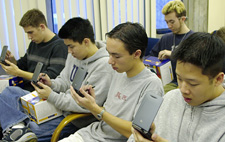 Calit² researchers at UCSD have launched an ambitious project called ActiveCampus to test whether wireless technology can be used to enhance the classroom-and campus-experience for students and professors alike. "Undergraduate enrollment alone will soar by 10,000 over the next decade, and that growth can threaten the sense of community," says professor Bill Griswold, who organized the ActiveCampus project and is the UCSD leader for Calit²'s Interfaces & Software Systems group . "We want to see if technology can enhance our 'culture of learning' and make the expanding campus seem somehow more intimate at the same time."
Calit² researchers at UCSD have launched an ambitious project called ActiveCampus to test whether wireless technology can be used to enhance the classroom-and campus-experience for students and professors alike. "Undergraduate enrollment alone will soar by 10,000 over the next decade, and that growth can threaten the sense of community," says professor Bill Griswold, who organized the ActiveCampus project and is the UCSD leader for Calit²'s Interfaces & Software Systems group . "We want to see if technology can enhance our 'culture of learning' and make the expanding campus seem somehow more intimate at the same time."
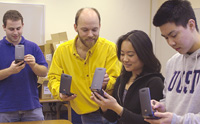 In mid-January, Griswold, a professor of Computer Science and Engineering at UCSD's Jacobs School of Engineering, distributed free personal digital assistants (PDAs) to more than 400 freshmen in computer science and computer engineering. The PDAs with wireless cards were donated by Calit² industry partner Hewlett-Packard, a gift worth approximately $480,000. When the students graduate, they get to keep the handheld devices.
In mid-January, Griswold, a professor of Computer Science and Engineering at UCSD's Jacobs School of Engineering, distributed free personal digital assistants (PDAs) to more than 400 freshmen in computer science and computer engineering. The PDAs with wireless cards were donated by Calit² industry partner Hewlett-Packard, a gift worth approximately $480,000. When the students graduate, they get to keep the handheld devices.
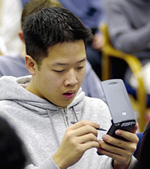 While students are encouraged to use the Jornada's built-in features for everything from class scheduling to taking notes, new applications designed for ActiveCampus require that they connect wirelessly through a virtual Web hub (http://activecampus.ucsd.edu) that is accessed via the high-speed 802.11b WiFi wireless data network installed in key buildings around campus. (Eventually, this could be supplemented with Bluetooth access over shorter distances.)
While students are encouraged to use the Jornada's built-in features for everything from class scheduling to taking notes, new applications designed for ActiveCampus require that they connect wirelessly through a virtual Web hub (http://activecampus.ucsd.edu) that is accessed via the high-speed 802.11b WiFi wireless data network installed in key buildings around campus. (Eventually, this could be supplemented with Bluetooth access over shorter distances.)
ActiveClass
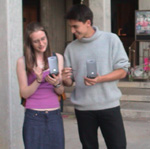 The first application up and running on the PDAs is called ActiveClass. On Jan. 24, more than 200 students in the two sections of lecturer Gary Gillespie's class on basic data structures and object-oriented design began using ActiveClass on their PDAs. It allows students to ask questions electronically, vote on which others' questions they most want answered, and respond to teacher polls. "The devices only added to the classroom experience and to the education of students," said Gillespie after the first class. "The most surprising aspect was seeing students ask insightful questions that I don't recall ever being asked in prior classes. I was very pleased to answer these questions that hadn't occurred to me, and the result is that all students were able to benefit."
The first application up and running on the PDAs is called ActiveClass. On Jan. 24, more than 200 students in the two sections of lecturer Gary Gillespie's class on basic data structures and object-oriented design began using ActiveClass on their PDAs. It allows students to ask questions electronically, vote on which others' questions they most want answered, and respond to teacher polls. "The devices only added to the classroom experience and to the education of students," said Gillespie after the first class. "The most surprising aspect was seeing students ask insightful questions that I don't recall ever being asked in prior classes. I was very pleased to answer these questions that hadn't occurred to me, and the result is that all students were able to benefit."
Student reaction was uniformly positive. "ActiveClass is very useful, especially when a student wants to ask a question without interrupting the class or the instructor," said Nobuhiro Makida, who also plans to use his HP Jornada to check e-mail and maintain his agenda and address book. The technology proved especially valuable to non-native English speakers. "Many students hesitate to ask questions in class, so this lets them post their questions without getting embarrassed," said Jana Kovacevic. "I think the professor will also get more feedback on the topic covered in class, as far as how much students understand and what areas need more emphasis." James Heffron says that having TAs online is also helpful. "When I'm taking notes in class I may not get a chance to check the web-board for questions," said the first-year student. "This way, the TA can monitor the questions for us." Heffron says he bought a keyboard for his Jornada, and now uses it to take notes for all his classes except physics--"due to the heavy use of mathematics and drawing that is involved in that class."
ActiveCampus Explorer
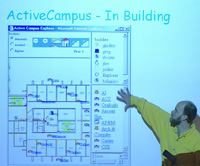 By the end of February, the experiment moves outside the classroom with a second application developed by Griswold and his researchers: ActiveCampus Explorer. "Our goal is to encourage chance interactions and discoveries around campus," Griswold told students while briefing them on the project. "We want ActiveCampus Explorer to point students back to opportunities in the physical world, not deeper into the PDA." Location sensing technology will allow students to pinpoint where friends are on campus, or get information about events or facilities nearby. Said Rosie Wu, a teaching assistant in Gary Gillespie's computer science class: "This capability will be very helpful if it leads to further direct contacts between students and their TAs or professors. Many times we have inconvenient office hours, so if ActiveCampus can help bridge that gap, it would immensely benefit everyone."
By the end of February, the experiment moves outside the classroom with a second application developed by Griswold and his researchers: ActiveCampus Explorer. "Our goal is to encourage chance interactions and discoveries around campus," Griswold told students while briefing them on the project. "We want ActiveCampus Explorer to point students back to opportunities in the physical world, not deeper into the PDA." Location sensing technology will allow students to pinpoint where friends are on campus, or get information about events or facilities nearby. Said Rosie Wu, a teaching assistant in Gary Gillespie's computer science class: "This capability will be very helpful if it leads to further direct contacts between students and their TAs or professors. Many times we have inconvenient office hours, so if ActiveCampus can help bridge that gap, it would immensely benefit everyone."
Griswold is also encouraging 'digital graffitti' that can be placed on the site signed or unsigned. Eventually, information could be "pushed" to the PDA as it registers a student's location near an event. "Imagine walking past the Price Center and getting a message that a free concert is about to begin, or about a book-signing in Geisel Library," says Griswold. "Above all, we are anxious to see the questions that emerge from students as they use this technology. We expect them to think up new ways to reinforce community within the classroom, and campus-wide."
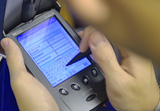 HP's major corporate sponsorship of the ActiveCampus project is complemented by others who are also providing support, including Symbol Technologies, MobilePlanet and Intel. Calit² is lending financial and administrative support to the ActiveCampus project.
HP's major corporate sponsorship of the ActiveCampus project is complemented by others who are also providing support, including Symbol Technologies, MobilePlanet and Intel. Calit² is lending financial and administrative support to the ActiveCampus project.
Related Links
